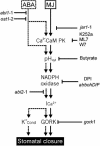Cytoplasmic alkalization precedes reactive oxygen species production during methyl jasmonate- and abscisic acid-induced stomatal closure
- PMID: 15064385
- PMCID: PMC419829
- DOI: 10.1104/pp.103.032250
Cytoplasmic alkalization precedes reactive oxygen species production during methyl jasmonate- and abscisic acid-induced stomatal closure
Abstract
Signaling events during abscisic acid (ABA) or methyl jasmonate (MJ)-induced stomatal closure were examined in Arabidopsis wild type, ABA-insensitive (ost1-2), and MJ-insensitive mutants (jar1-1) in order to examine a crosstalk between ABA and MJ signal transduction. Some of the experiments were performed on epidermal strips of Pisum sativum. Stomata of jar1-1 mutant plants are insensitive to MJ but are able to close in response to ABA. However, their sensitivity to ABA is less than that of wild-type plants. Reciprocally, the stomata of ost1-2 are insensitive to ABA but are able to close in response to MJ to a lesser extent compared to wild-type plants. Both MJ and ABA promote H(2)O(2) production in wild-type guard cells, while exogenous application of diphenylene iodonium (DPI) chloride, an inhibitor of NAD(P)H oxidases, results in the suppression of ABA- and MJ-induced stomatal closure. ABA elevates H(2)O(2) production in wild-type and jar1-1 guard cells but not in ost1-2, whereas MJ induces H(2)O(2) production in both wild-type and ost1-2 guard cells, but not in jar1-1. MJ-induced stomatal closing is suppressed in the NAD(P)H oxidase double mutant atrbohD/F and in the outward potassium channel mutant gork1. Furthermore, MJ induces alkalization in guard cell cytosol, and MJ-induced stomatal closing is inhibited by butyrate. Analyses of the kinetics of cytosolic pH changes and reactive oxygen species (ROS) production show that the alkalization of cytoplasm precedes ROS production during the stomatal response to both ABA and MJ. Our results further indicate that JAR1, as OST1, functions upstream of ROS produced by NAD(P)H oxidases and that the cytoplasmic alkalization precedes ROS production during MJ or ABA signal transduction in guard cells.
Figures








Similar articles
-
Cytosolic alkalization and cytosolic calcium oscillation in Arabidopsis guard cells response to ABA and MeJA.Plant Cell Physiol. 2010 Oct;51(10):1721-30. doi: 10.1093/pcp/pcq131. Epub 2010 Aug 24. Plant Cell Physiol. 2010. PMID: 20739306
-
Involvement of OST1 Protein Kinase and PYR/PYL/RCAR Receptors in Methyl Jasmonate-Induced Stomatal Closure in Arabidopsis Guard Cells.Plant Cell Physiol. 2016 Aug;57(8):1779-90. doi: 10.1093/pcp/pcw102. Epub 2016 May 20. Plant Cell Physiol. 2016. PMID: 27354421
-
Ethylene Inhibits Methyl Jasmonate-Induced Stomatal Closure by Modulating Guard Cell Slow-Type Anion Channel Activity via the OPEN STOMATA 1/SnRK2.6 Kinase-Independent Pathway in Arabidopsis.Plant Cell Physiol. 2019 Oct 1;60(10):2263-2271. doi: 10.1093/pcp/pcz121. Plant Cell Physiol. 2019. PMID: 31241163
-
Methyl jasmonate signaling and signal crosstalk between methyl jasmonate and abscisic acid in guard cells.Plant Signal Behav. 2011 Jul;6(7):939-41. doi: 10.4161/psb.6.7.15439. Plant Signal Behav. 2011. PMID: 21681023 Free PMC article. Review.
-
Signaling Transduction of ABA, ROS, and Ca2+ in Plant Stomatal Closure in Response to Drought.Int J Mol Sci. 2022 Nov 26;23(23):14824. doi: 10.3390/ijms232314824. Int J Mol Sci. 2022. PMID: 36499153 Free PMC article. Review.
Cited by
-
Aquaporins Contribute to ABA-Triggered Stomatal Closure through OST1-Mediated Phosphorylation.Plant Cell. 2015 Jul;27(7):1945-54. doi: 10.1105/tpc.15.00421. Epub 2015 Jul 10. Plant Cell. 2015. PMID: 26163575 Free PMC article.
-
Convergence and Divergence of Signaling Events in Guard Cells during Stomatal Closure by Plant Hormones or Microbial Elicitors.Front Plant Sci. 2016 Aug 24;7:1332. doi: 10.3389/fpls.2016.01332. eCollection 2016. Front Plant Sci. 2016. PMID: 27605934 Free PMC article. Review.
-
Glutathione reductase in leaves of cowpea: cloning of two cDNAs, expression and enzymatic activity under progressive drought stress, desiccation and abscisic acid treatment.Ann Bot. 2006 Dec;98(6):1279-87. doi: 10.1093/aob/mcl217. Epub 2006 Sep 28. Ann Bot. 2006. PMID: 17008354 Free PMC article.
-
Improvement of plant tolerance to drought stress by cotton tubby-like protein 30 through stomatal movement regulation.J Adv Res. 2022 Dec;42:55-67. doi: 10.1016/j.jare.2022.06.007. Epub 2022 Jun 20. J Adv Res. 2022. PMID: 35738523 Free PMC article.
-
ROS of Distinct Sources and Salicylic Acid Separate Elevated CO2-Mediated Stomatal Movements in Arabidopsis.Front Plant Sci. 2020 May 8;11:542. doi: 10.3389/fpls.2020.00542. eCollection 2020. Front Plant Sci. 2020. PMID: 32457781 Free PMC article.
References
-
- Ache P, Becker D, Ivashikina N, Dietrich P, Roelfsema MR, Hedrich R (2000) GORK, a delayed outward rectifier expressed in guard cells of Arabidopsis thaliana, is a K+-selective, K+-sensing ion channel. FEBS Lett 486: 93–98 - PubMed
-
- Agrios GN (1997) Plant Pathology, Ed 4. Academic Press, San Diego, pp 46–52
-
- Allen GJ, Chu SP, Schumacher K, Shimazaki CT, Vafeados D, Kemper A, Hawke SD, Tallman G, Tsien RY, Harper JF (2000) Alternation of stimulus-specific guard cell calcium oscillations and stomatal closing in Arabidopsis det3 mutant. Science 289: 2338–2342 - PubMed
Publication types
MeSH terms
Substances
Grants and funding
LinkOut - more resources
Full Text Sources
Other Literature Sources
Molecular Biology Databases

